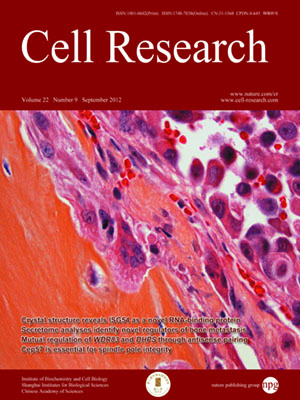
Volume 22, No 9, Sep 2012
ISSN: 1001-0602
EISSN: 1748-7838 2018
impact factor 17.848*
(Clarivate Analytics, 2019)
Volume 22 Issue 9, September 2012: 1374-1389
ORIGINAL ARTICLES
Bidirectional regulation between WDR83 and its natural antisense transcript DHPS in gastric cancer
Wen-Yu Su1,*, Jiong-Tang Li2,3,*, Yun Cui1, Jie Hong1, Wan Du1, Ying-Chao Wang1, Yan-Wei Lin1, Hua Xiong1, Ji-Lin Wang1, Xuan Kong1, Qin-Yan
1GI Division, Shanghai Jiao-Tong University School of Medicine Renji Hospital, Shanghai Institution of Digestive Disease; Key Laboratory of Gastroenterology & Hepatology, Ministry of Health (Shanghai Jiao-Tong University); State Key Laboratory of Oncogene and Related Genes, 145 Middle Shandong Rd, Shanghai 200001, China
2Chinese Academy of Fishery Science, Ministry of Agriculture, 150 Qingta, Yongding Rd, Beijing 100141, China
3Center for Bioinformatics, National Laboratory of Protein Engineering and Plant Genetic Engineering, College of Life Sciences, Peking University, 5 Yiheyuan Rd, Beijing 100871, China
Correspondence: Jing-Yuan Fang(fangjingyuan_new@163.com)
Natural antisense transcripts (NATs) exist ubiquitously in mammalian genomes and play roles in the regulation of gene expression. However, both the existence of bidirectional antisense RNA regulation and the possibility of protein-coding genes that function as antisense RNAs remain speculative. Here, we found that the protein-coding gene, deoxyhypusine synthase (DHPS), as the NAT of WDR83, concordantly regulated the expression of WDR83 mRNA and protein. Conversely, WDR83 also regulated DHPS by antisense pairing in a concordant manner. WDR83 and DHPS were capable of forming an RNA duplex at overlapping 3′ untranslated regions and this duplex increased their mutual stability, which was required for the bidirectional regulation. As a pair of protein-coding cis-sense/antisense transcripts, WDR83 and DHPS were upregulated simultaneously and correlated positively in gastric cancer (GC), driving GC pathophysiology by promoting cell proliferation. Furthermore, the positive relationship between WDR83 and DHPS was also observed in other cancers. The bidirectional regulatory relationship between WDR83 and DHPS not only enriches our understanding of antisense regulation, but also provides a more complete understanding of their functions in tumor development.
Cell Research (2012) 22:1374-1389. doi:10.1038/cr.2012.57; published online 10 April 2012
FULL TEXT | PDF
Browse 2164


